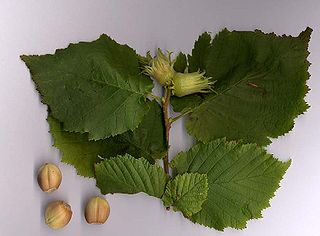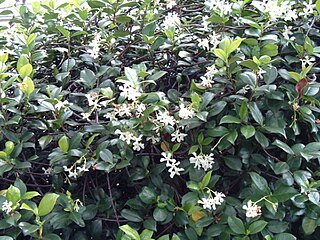
Hornbeams are hardwood trees in the plant genus Carpinus in the family Betulaceae. The 30–40 species occur across much of the temperate regions of the Northern Hemisphere.

Hazels are plants of the genus Corylus of deciduous trees and large shrubs native to the temperate Northern Hemisphere. The genus is usually placed in the birch family Betulaceae, though some botanists split the hazels into a separate family Corylaceae. The fruit of the hazel is the hazelnut.

Tsuga is a genus of conifers in the subfamily Abietoideae of Pinaceae, the pine family. The common name hemlock is derived from a perceived similarity in the smell of its crushed foliage to that of the unrelated plant poison hemlock. Unlike the latter, Tsuga species are not poisonous.

Corylus avellana, the common hazel, is a species of flowering plant in the birch family Betulaceae, native to Europe and Western Asia. It is an important component of the hedgerows that were, historically, used as property and field boundaries in lowland England. The wood was traditionally grown as coppice, with the poles cut being used for wattle-and-daub building, and agricultural fencing.

Ostrya is a genus of eight to 10 small deciduous trees belonging to the birch family Betulaceae. Common names include hop-hornbeam and hophornbeam. It may also be called ironwood, a name shared with a number of other plants.

Photinia is a genus of about 30 species of small trees and large shrubs, but the taxonomy has recently varied greatly, with the genera Heteromeles, Stranvaesia and Aronia sometimes included in Photinia.

Corylus maxima, the filbert, is a species of hazel in the birch family Betulaceae, native to southeastern Europe and southwestern Asia, from the Balkans to Ordu in Turkey.

Corylus cornuta, the beaked hazelnut, is a deciduous shrubby hazel with two subspecies found throughout most of North America.

Keteleeria is a genus of three species of coniferous trees in the family Pinaceae first described as a genus in 1866.

The hazel dormouse or common dormouse is a small dormouse species native to Europe and the only living species in the genus Muscardinus.

Osmanthus is a genus of about 30 species of flowering plants in the family Oleaceae. Most of the species are native to eastern Asia with a few species from the Caucasus, New Caledonia, and Sumatra. Osmanthus has been known in China since ancient times with the earliest writings coming from the Warring States period; the book Sea and Mountain. South Mountain states: "Zhaoyao Mountain had a lot of Osmanthus".

Trachelospermumstar jasmine, Confederate jasmine, is a genus of evergreen woody vines in the dogbane family Apocynaceae, first described as a genus in 1851. All species are native to southern and eastern Asia.

Keteleeria davidiana is a coniferous evergreen tree native to Taiwan and southeast China, in the provinces of Gansu, Guangxi, Guizhou, Hubei, Hunan, Shaanxi, Sichuan, and Yunnan. It also occurs in the very northern part of Vietnam. The tree is restricted to hills, mountains, and valleys at elevations of 200–1500 m. Generally, it grows in regions with a more continental climate than the other two Keteleeria species.

The Helan Shan pika or silver pika is a species of mammal in the pika family, Ochotonidae. It is endemic to China where it is found in a small region of the Helan Mountains. It is listed as "Endangered" in the IUCN Red List of Threatened Species as of 2016.

Caryopteris is a genus of flowering plants in the family Lamiaceae. They are native to east Asia.

Corylus heterophylla, the Asian hazel, is a species of hazel native to eastern Asia in northern and central China, Korea, Japan, and southeastern Siberia.

Corylus yunnanensis, the Yunnan hazel, is a species of hazelnut found in western China. It is a small tree or shrub. The flowers have triangular shaped petals. The round nuts which are encased in a very tough oval shaped shell and can be consumed by humans. The plant is not commercially grown for the nuts, rather they are sometimes used as ornamental plants. They are located in Western Guizhou, Hubei, South Western and Western Sichuan, and Western Yunnan.
Ostryopsis nobilis is a shrub species in the genus Ostryopsis found in China. It is an endemic Chinese medicinal plant. It forms thickets on sunny mountain slopes between 1500 and 3000 m. It is found in South West Sichuan and North West Yunnan.
Iris dolichosiphon is a plant species in the genus Iris, it is also in the subgenus Iris and in the section Pseudoregelia. It is a rhizomatous perennial, from China and Bhutan. It has long, thin dark green leaves, very short stem, and dark blue, purple, or violet flowers. That are mottled with white. It has thick white/orange beards. It has one subspecies, Iris dolichosiphon subsp. orientalis, from China, India and Burma. It has similar flowers. They are cultivated as ornamental plants in temperate regions

Catalpa fargesii, the Chinese bean tree, is a species of tree in the family Bignoniaceae, native to China. Growing to about 25 m tall, it is a deciduous tree which produces abundant pink blossom in spring, followed by narrow brown beans-like fruit in the autumn. Some sources place the species as a synonym of Catalpa bungei.


















